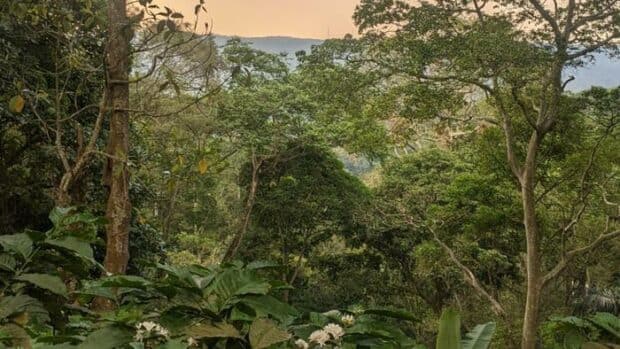As agricultural goods go, coffee has a particularly high potential to combine forest conservation, biodiversity and production output, according to a meta analysis published this spring.
A team of researchers at Oxford Brookes University in the UK led the analysis, which explored 69 studies drawn from an original pool of 1,900 academic papers involving shade-grown coffee, conservation and related topics.
Offering the standard caveat that there are no one-size-fits-all solutions in coffee production, they concluded that coffee grown in high shade, with 30% or more canopy cover, results in greater biodiversity and and reduced agriculture-driven deforestation.
The findings are particularly relevant as the European coffee industry — and, by market extension, the global coffee industry — as it prepares for the enforcement of the new EU deforestation-free supply chain law known as EUDR.
“Agriculture is one of the greatest threats facing species around the world. Whether it is cutting down trees to make way for farms, or using chemical pesticides and fertilizers, bad farming practices can hold dire consequences,” the new study’s lead author, Sophie Manson, said in an announcement of the publication. “Yet it doesn’t have to be this way. Paving the way in combining agriculture and conservation, shade-grown coffee has the ability to challenge our perception of agriculture, and reframe the way we look at farming.”
While primarily focused on deforestation and biodiversity loss, the meta-analysis also resulted in a financial argument for shade-grown coffee production.
Other recent studies have backed this this argument, finding that coffee grown with full or partial shade cover can benefit from increased pollinator activity resulting in healthier plants, increased potential for other cash or food crops on the same land, better protection against climate change, reduced dependence on expensive chemical inputs and improved long-term soil health.
“We showed that several groups of species with important roles for ecosystems and humans, such as pollinators, are penalized by shade tree removal,” meta-analysis co-author Marco Campera said. “This in turn can lead to a loss in profits for farmers and cause management costs to increase through agrochemicals. Therefore, traditional ways of cultivating coffee and other non-timber forest products, such as growing them under shade, should be prioritized.”
Notably, the meta-analysis found that species diversity tended to increase among coffee farms studied in Latin America with higher canopy cover, yet the opposite tended to hold true in parts of Africa.
The authors similarly noted that coffee does not exist in a silo in regards to conservation and agricultural-driven deforestation.
Said Manson, “Our focus now should lie in conservation and how we can optimize productivity alongside biodiversity.”
The full study, “Effect of shade on biodiversity within coffee farms: A meta-analysis,” was published in the Elsevier title Science of the Total Environment.
Comments? Questions? News to share? Contact DCN’s editors here.
Related Posts
Nick Brown Nick Brown is the editor of Daily Coffee News by Roast Magazine.


